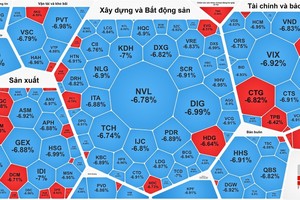While the idea of relocating enterprises causing pollution, or employing a huge work force, outside of Ho Chi Minh City limits seems like a healthy policy, actually transferring them to the suburbs or outlying provinces has many obstacles.

HCMC and the southern provinces of Binh Duong and Dong Nai are considered as centers for production of textiles and garments in the country.
Statistics of Vietnam Textile & Apparel Association (VITAS) show that among 3,700 textile and garment enterprises, 2,146 of these are based in HCMC and the two above mentioned provinces.
These make up for 58 percent of the enterprises, while the Red River Delta has 27 percent, the north central region and central coastal provinces have 7 percent, Mekong delta provinces have 4 percent and highland provinces have 1 percent.
According to the HCMC economic development strategy, pollution causing enterprises with excess work force are being asked to move out of the City in a bid to reduce immigrants crowding big cities.
In response to this plan policy, many textile and garment companies have moved to Mekong delta provinces and central coastal provinces, but these are those companies with enormous economic resources at their disposal.
Nonetheless, all these enterprises are facing difficulties in recruiting new labor force in new areas of Mekong delta provinces and central coastal provinces, where there is still lack of skilled and efficient workers. In addition, moving enterprises to provinces far from the city increases transportation costs.
One director of a textile company tells a story about an American importer who wanted to place orders in the Mekong delta province of An Giang to avail of cheaper labor costs; however, after calculating transportation costs and other overheads, he decided to place orders with a textile company in HCMC.
This creates unhealthy and unfair competition between enterprises that are far from the city, making it also very difficult to attract orders.
Even enterprises moving to suburban districts close to the City face recruitment problems. A company in Tan Binh District moaned that more and more workers are handing their resignations after the company removed to Cu Chi District, as they say they waste time travelling to and fro from the City.
The company is now having to spend much more on severance payment and recruitment of new labor that are not as skilled and experienced like the old workers.
Le Dong Trieu, director of Gia Dinh Garment Company, said that dyeing companies are being threatened with constant closure because of threat of pollution by provinces. Gia Dinh was refused permission to move its dyeing unit to the southern provinces of Long An and Tay Ninh.
To be able to fulfill every environmental safety condition, enterprises have to pump millions and millions of dollars to install international standards waste treatment systems, which is difficult, seeing that most of the enterprises are constantly facing a capital crunch.
Trieu said they need government support and more investment to sustain dyeing and fabric enterprises.
























